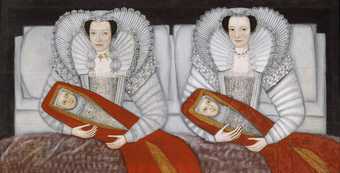
Unknown artist, Britain, The Cholmondeley Ladies c.1600–10. Tate.
Exiles and Dynasties 1545–1640
17 rooms in Historic and Early Modern British Art
The grand portraits in this room tell stories of migration and power. They date from the last years of Henry VIII’s reign to the time of Charles I
During this period, the most successful artists in Britain are immigrants, mainly from northern Europe. Many arrive as refugees fleeing religious persecution in their home countries. Others come here to seek out new professional opportunities. Since the Protestant Reformation and Henry VIII’s break from the Catholic Church, religious images have been destroyed in England. Artists now focus on painting exquisite portraits of royals and aristocrats.
This is an era when England is beginning to compete with other European powers around the world. Elizabeth I grants a Royal Charter to the East India Company, authorising them to attack Dutch and Portuguese ships that trade spices and textiles with Asia. Other English trading companies start to colonise the eastern coast of North America, between the territories claimed by France and Spain. The islands of St Kitts, Barbados, and Nevis become the first permanent English colonies in the Caribbean. English privateers profit from trafficking enslaved people from West Africa across the Atlantic to the Americas. Closer to home, military campaigns are waged in Ireland to reassert control over the Gaelic population.
Many wealthy aristocrats in Britain profit from this growing international power. They commission spectacular paintings of themselves by some of Europe’s greatest artists, particularly those from the Low Countries (present-day Belgium and the Netherlands). The intricate depictions of opulent clothing, jewels and coats of arms celebrate the fame, status and family dynasty of the sitters. Van Dyck’s dramatically lavish style will go on to have a profound influence on future generations of British artists.
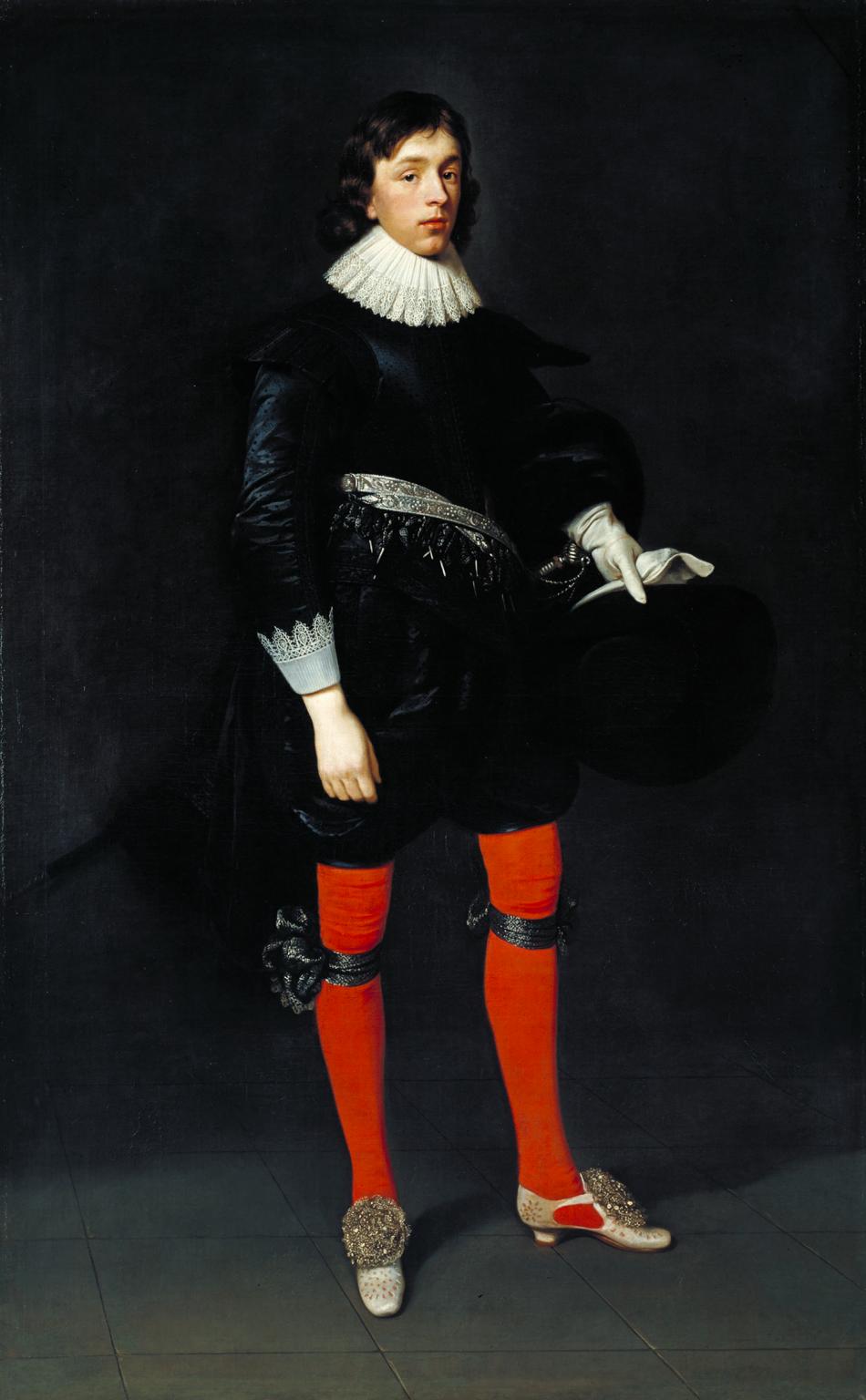
Daniel Mytens the Elder, Portrait of James Hamilton, Earl of Arran, Later 3rd Marquis and 1st Duke of Hamilton, Aged 17 1623
Daniel Mytens trained in the Netherlands and worked in England from 1618. Compared with local artists, he offered a striking naturalism. Hamilton shared an interest in art-collecting with the future king Charles I, whom Mytens painted in a similar pose. In 1623, the date of this picture, Hamilton had accompanied the then-prince Charles to Madrid during his unsuccessful attempt to marry a Spanish princess. Years later, during the Civil War, the royalist Hamilton was beheaded, shortly after Charles himself.
Gallery label, July 2024
1/24
artworks in Exiles and Dynasties
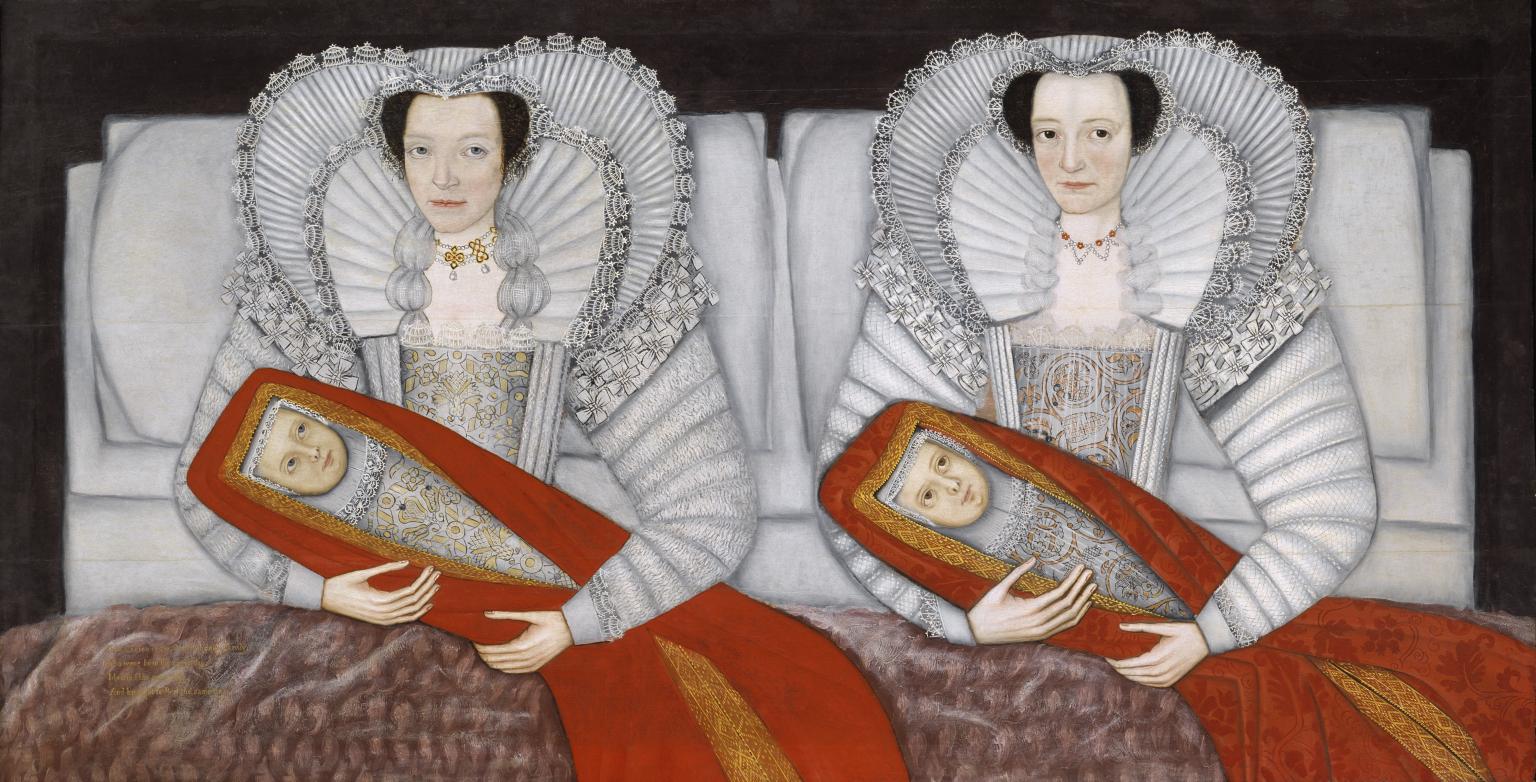
Unknown artist, Britain, The Cholmondeley Ladies c.1600–10
According to the inscription (bottom left), this painting shows ‘Two Ladies of the Cholmondeley Family, Who were born the same day, Married the same day, And brought to Bed [gave birth] the same day’. To mark this dynastic event, they are formally presented in bed, their babies wrapped in scarlet fabric. Identical at a superficial glance, the lace, jewellery and eye colours of the ladies and infants are in fact carefully differentiated. The format echoes tomb sculpture of the period. The identity of the women is unclear.
Gallery label, July 2024
2/24
artworks in Exiles and Dynasties
Mona Hatoum, Exodus 2 Date not known
3/24
artworks in Exiles and Dynasties
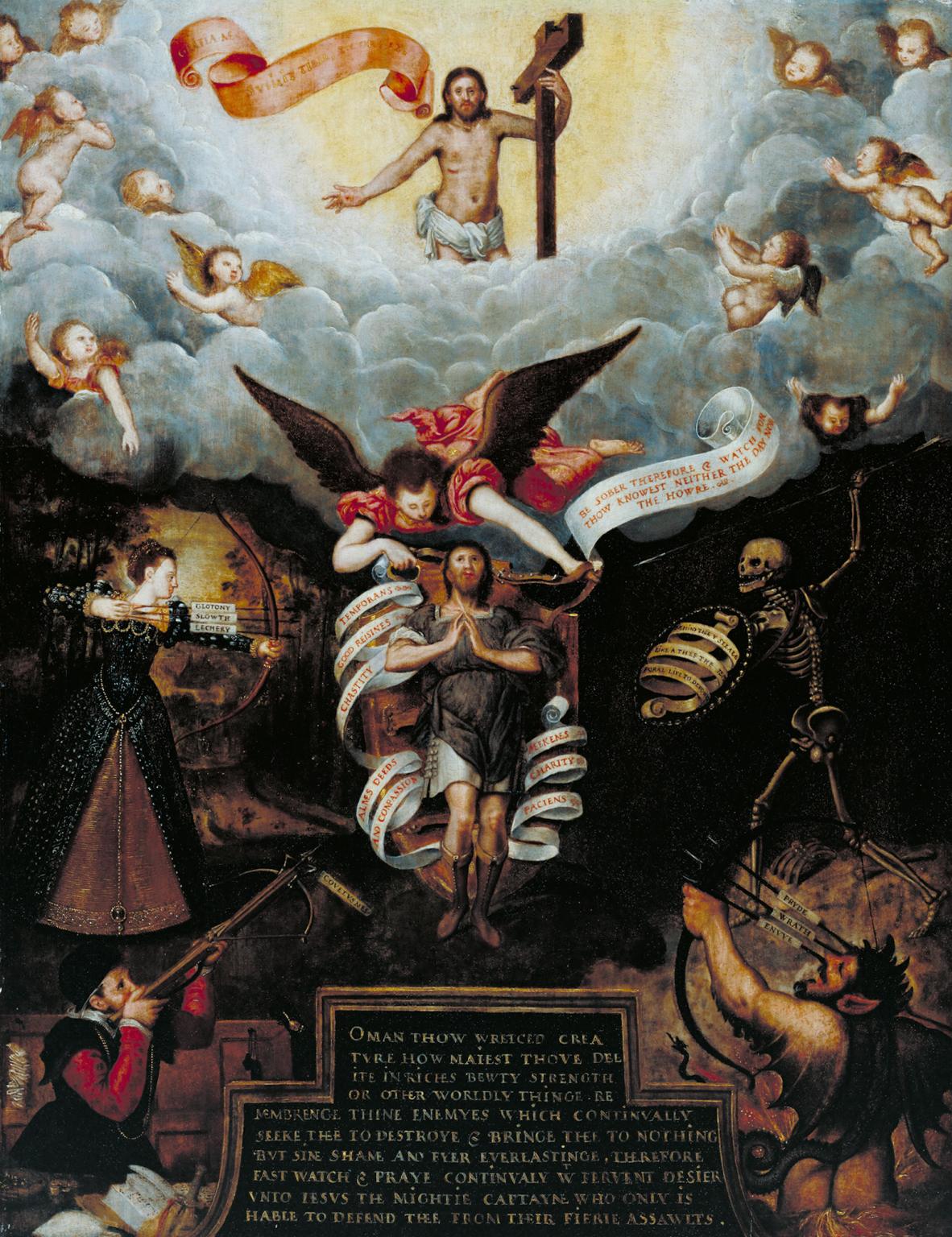
Unknown artist, Britain, An Allegory of Man 1596 or after
Extremely few British paintings of religious subjects have survived from the 16th century. After the Reformation, Protestant unease about images meant it would have been highly controversial to display religious paintings. The inscription at the bottom, in English, warns against the evil of worldly vanity. Instead, it urges prayer to ensure the safe passage of the soul to heaven. The resurrected Christ appears at the top. Below him, at the centre, is Man, shielded by Christian and moral virtues against attacks from all sides by the Seven Deadly Sins.
Gallery label, July 2024
4/24
artworks in Exiles and Dynasties
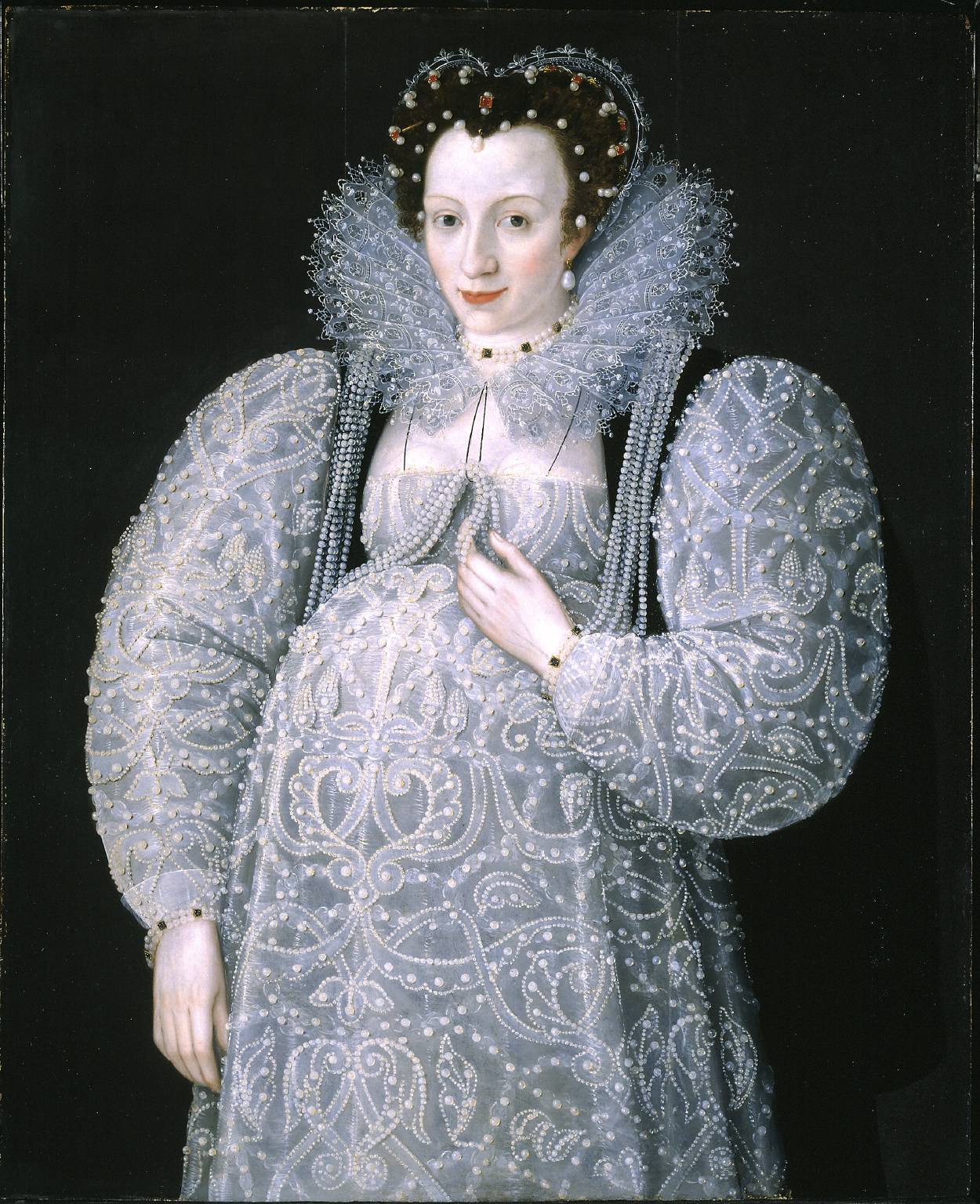
attributed to Marcus Gheeraerts II, Portrait of an Unknown Lady c.1595
This portrait depicts a pregnant woman. At this time before modern medicine, pregnancy was dangerous, and women often died in childbirth. Yet, producing an heir to an elite family was considered an important duty of a wife. This painting celebrates the woman’s role in continuing her husband’s family line. We don’t know the identity of the sitter, but her elaborate clothing demonstrates she was wealthy and of high status. The pearls are symbols of moral purity, as monogamy for women in this period was imperative. She smiles, unusual in portraits of this time.
Gallery label, July 2024
5/24
artworks in Exiles and Dynasties
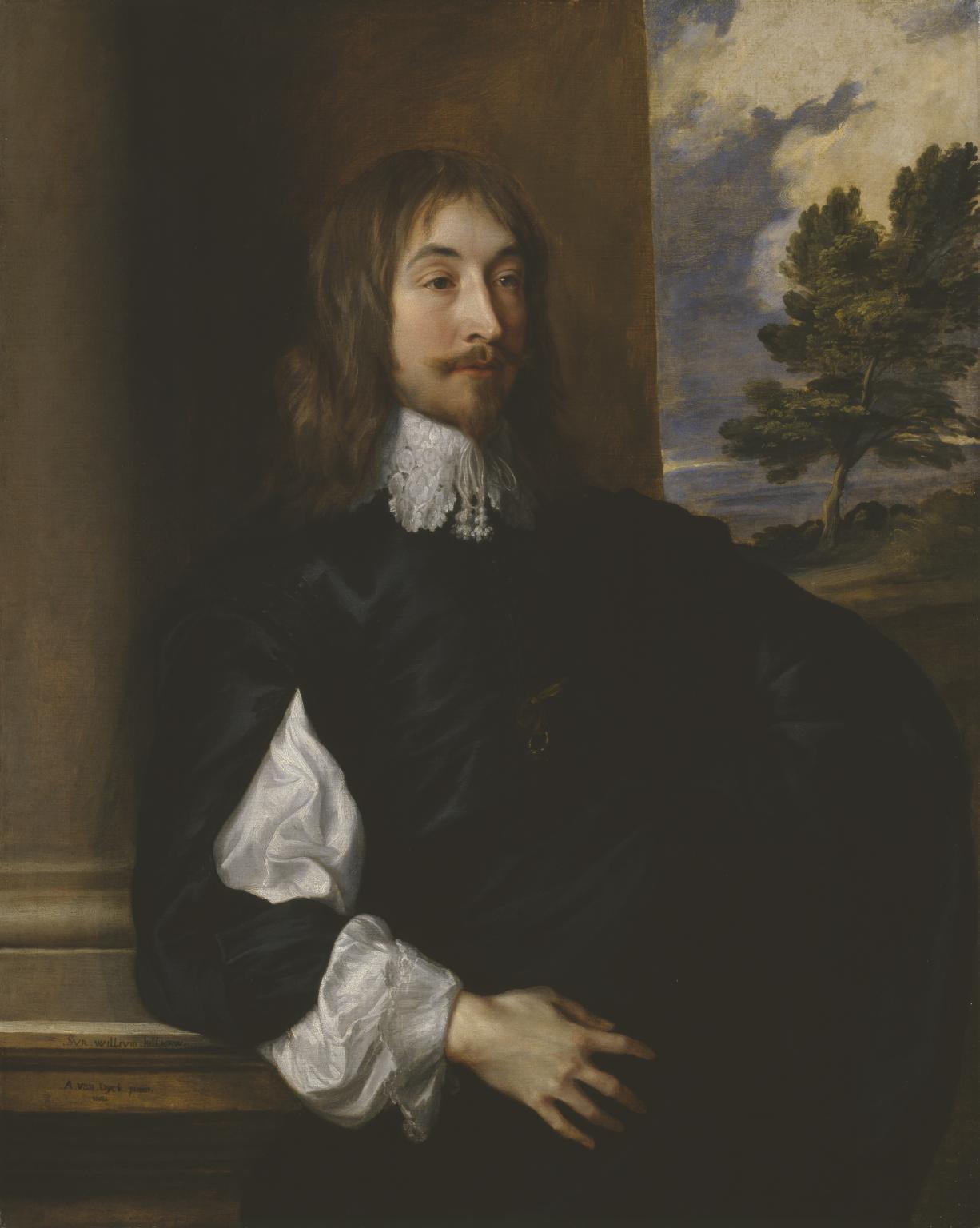
Sir Anthony Van Dyck, Portrait of Sir William Killigrew 1638
Sir William Killigrew was a courtier to Charles I and, after the Restoration, Charles II. He was appointed Vice-Chamberlain to the queen, Catherine of Braganza, an influential and well rewarded post. He was also a noted playwright. The ring tied by a ribbon to his black satin jacket may allude romantically to his wife or denote mourning for a friend or relative. The composition and landscape echo the work of the 16th-century Venetian painter Titian. Titian’s paintings were admired by Charles I and his court, and greatly influenced van Dyck.
Gallery label, July 2024
6/24
artworks in Exiles and Dynasties
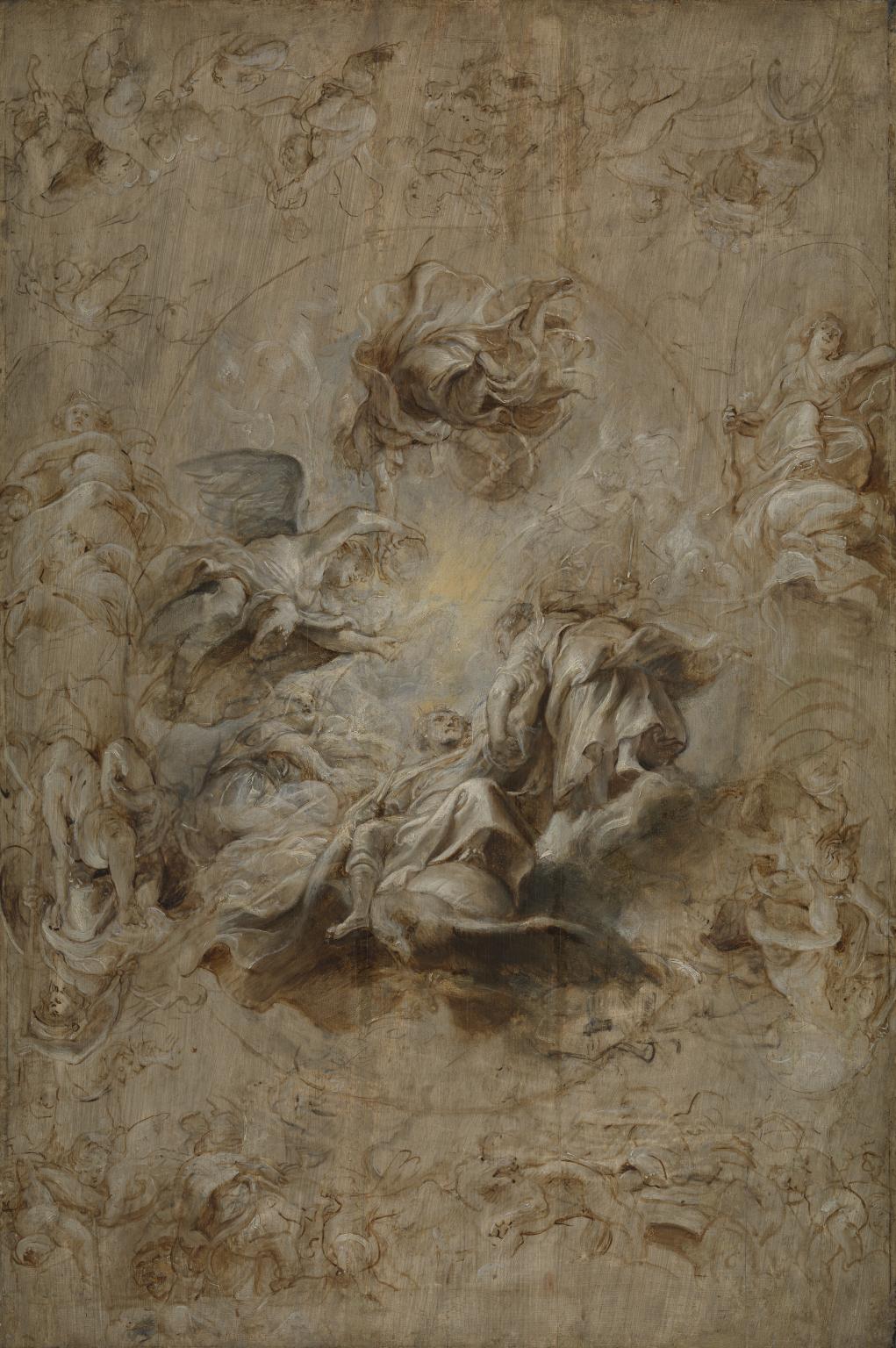
Sir Peter Paul Rubens, The Apotheosis of James I and Other Studies: Multiple Sketch for the Banqueting House Ceiling, Whitehall c.1628–30
This is a sketch for the ceiling paintings of the Banqueting House at Whitehall Palace. Charles I commissioned them to celebrate the reign of his father, James I. James is being lifted up to heaven, seated on a globe. The figure of Justice guides him to be crowned by Minerva (goddess of Wisdom) and Victory. ‘Apotheosis’ is the transformation from human to divine.
Gallery label, July 2024
7/24
artworks in Exiles and Dynasties
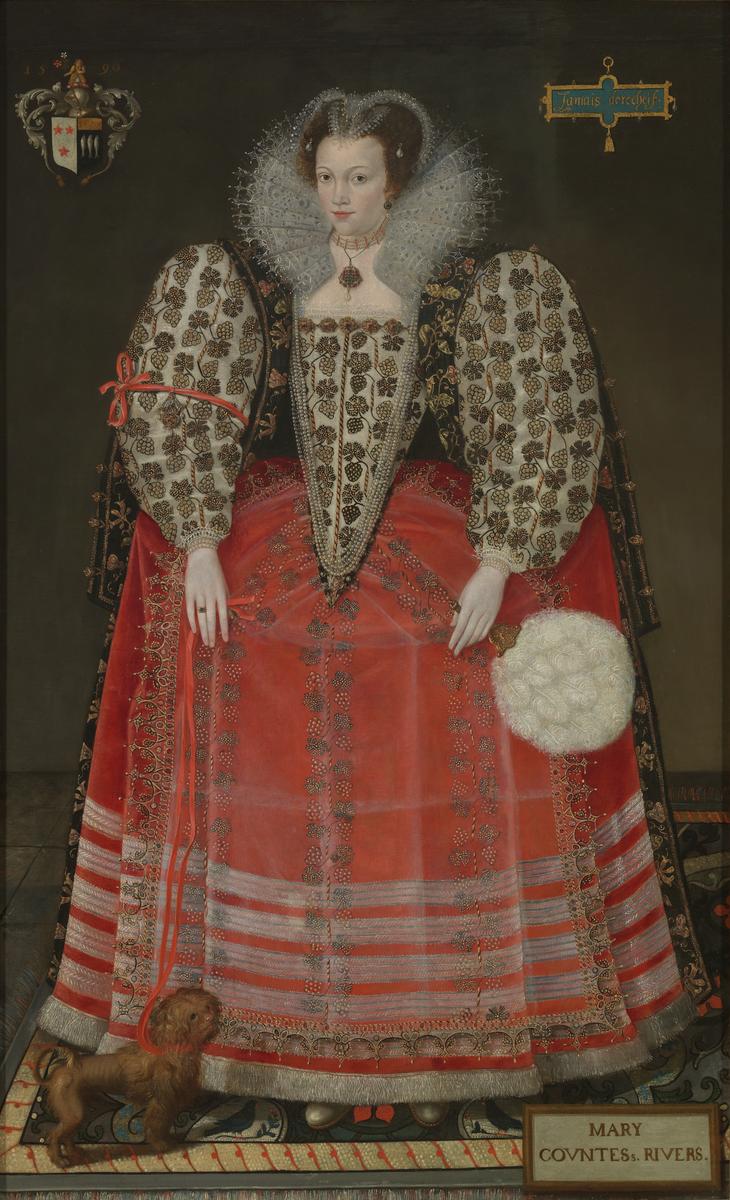
Unknown artist, Britain, Portrait of Mary Kytson, Lady Darcy of Chiche, later Lady Rivers c.1590
The inscription (bottom right) identifies this sumptuously dressed woman as Mary, the wife of Thomas, 3rd Baron Darcy of Chiche, later the Earl Rivers. The couple were to separate in 1594, unusual in marriages of this time. Mary’s white sleeves and stomacher are embroidered with hops and carnations, and her black sleeveless gown with honeysuckle. Earlier portraits of Mary’s parents, Lord and Lady Kytson, hang nearby. They once hung at the Kytsons’ Suffolk house, Hengrave Hall. The French inscription, top right, means roughly ‘never act in haste.
Gallery label, July 2024
8/24
artworks in Exiles and Dynasties
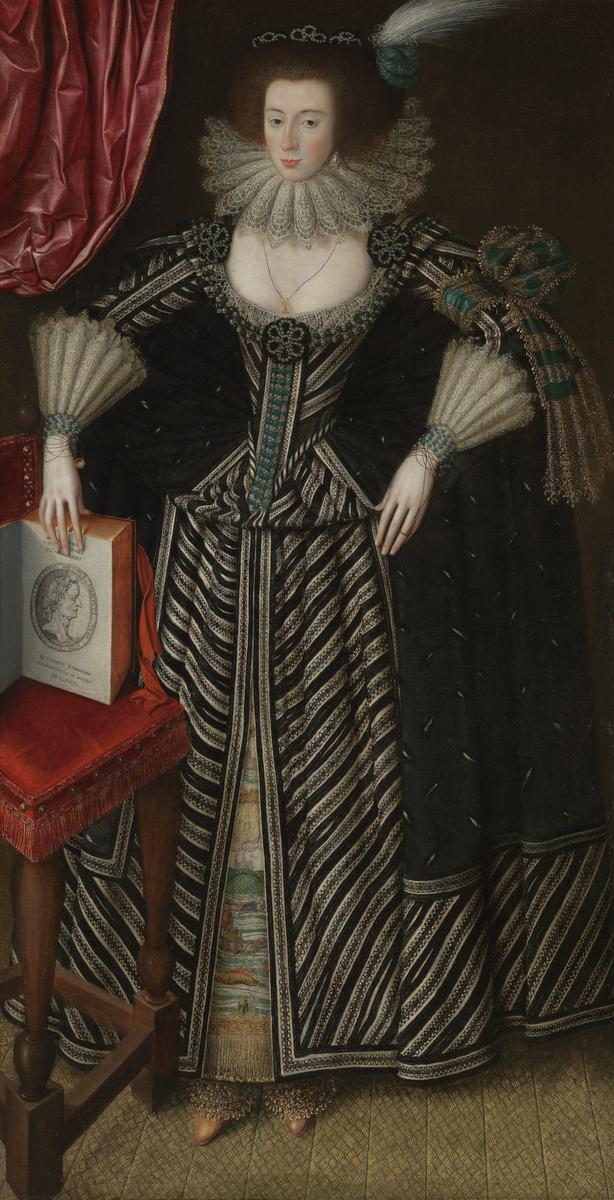
Unknown artist, Britain, Portrait of a Lady, probably Mrs Clement Edmondes c.1605–10
The inscription (bottom right) identifies this sumptuously dressed woman as Mary, the wife of Thomas, 3rd Baron Darcy of Chiche, later the Earl Rivers. The couple were to separate in 1594, unusual in marriages of this time. Mary’s white sleeves and stomacher are embroidered with hops and carnations, and her black sleeveless gown with honeysuckle. Earlier portraits of Mary’s parents, Lord and Lady Kytson, hang nearby. They once hung at the Kytsons’ Suffolk house, Hengrave Hall. The French inscription, top right, means roughly ‘never act in haste.
Gallery label, July 2024
9/24
artworks in Exiles and Dynasties
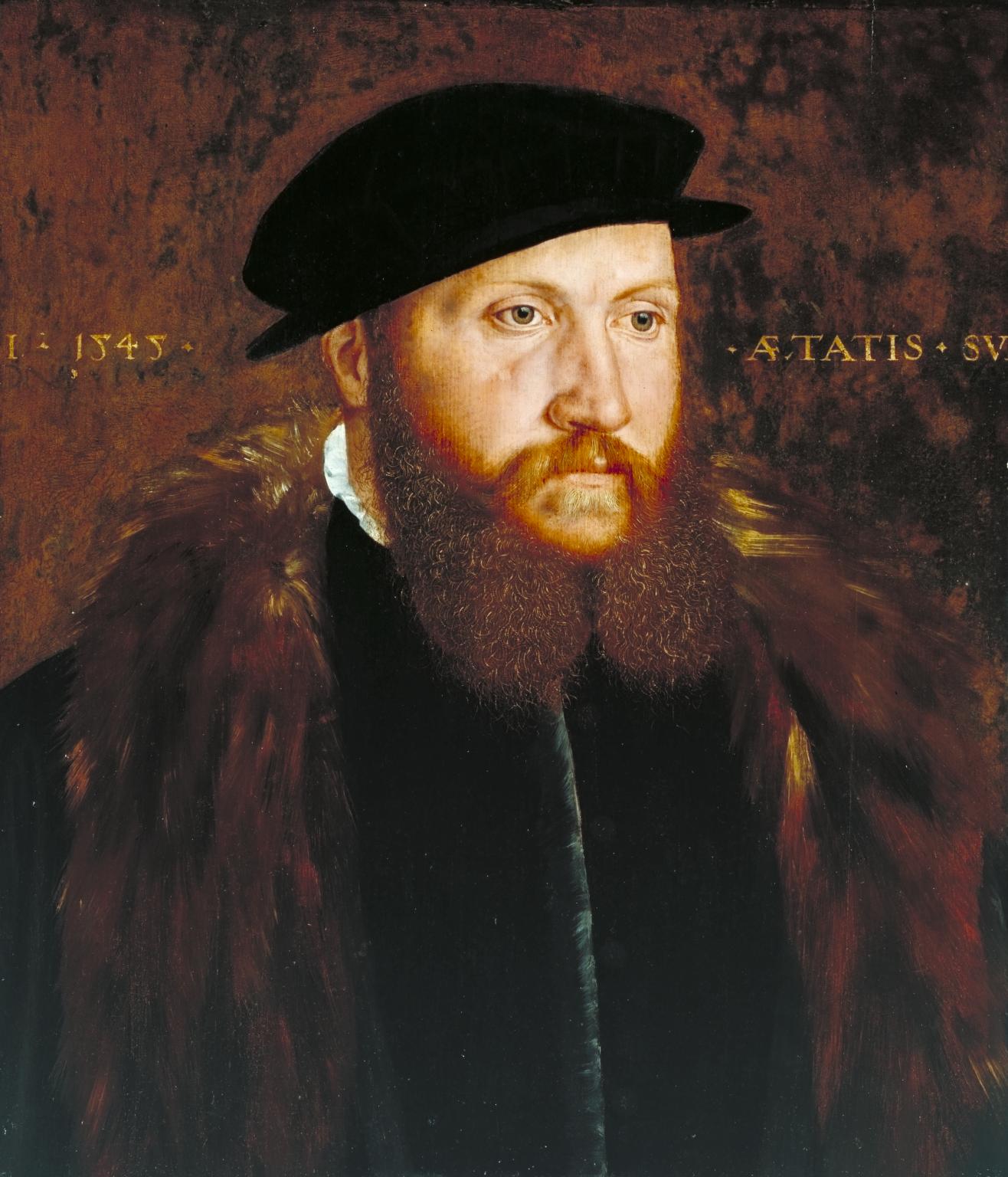
John Bettes, A Man in a Black Cap 1545
This is the oldest picture in the Tate collection. The artist’s name is inscribed on the back. The writing on the front indicates that the work was painted ‘in the year of our Lord 1545’, and the sitter was aged 26. John Bettes is first recorded in 1531 as carrying out decorative work for Henry VIII’s court. He may have worked with Hans Holbein the Younger, the prestigious Tudor painter. Originally this portrait was larger and would have had a blue background. The pigment (smalt) has degraded and changed to brown.
Gallery label, July 2024
10/24
artworks in Exiles and Dynasties
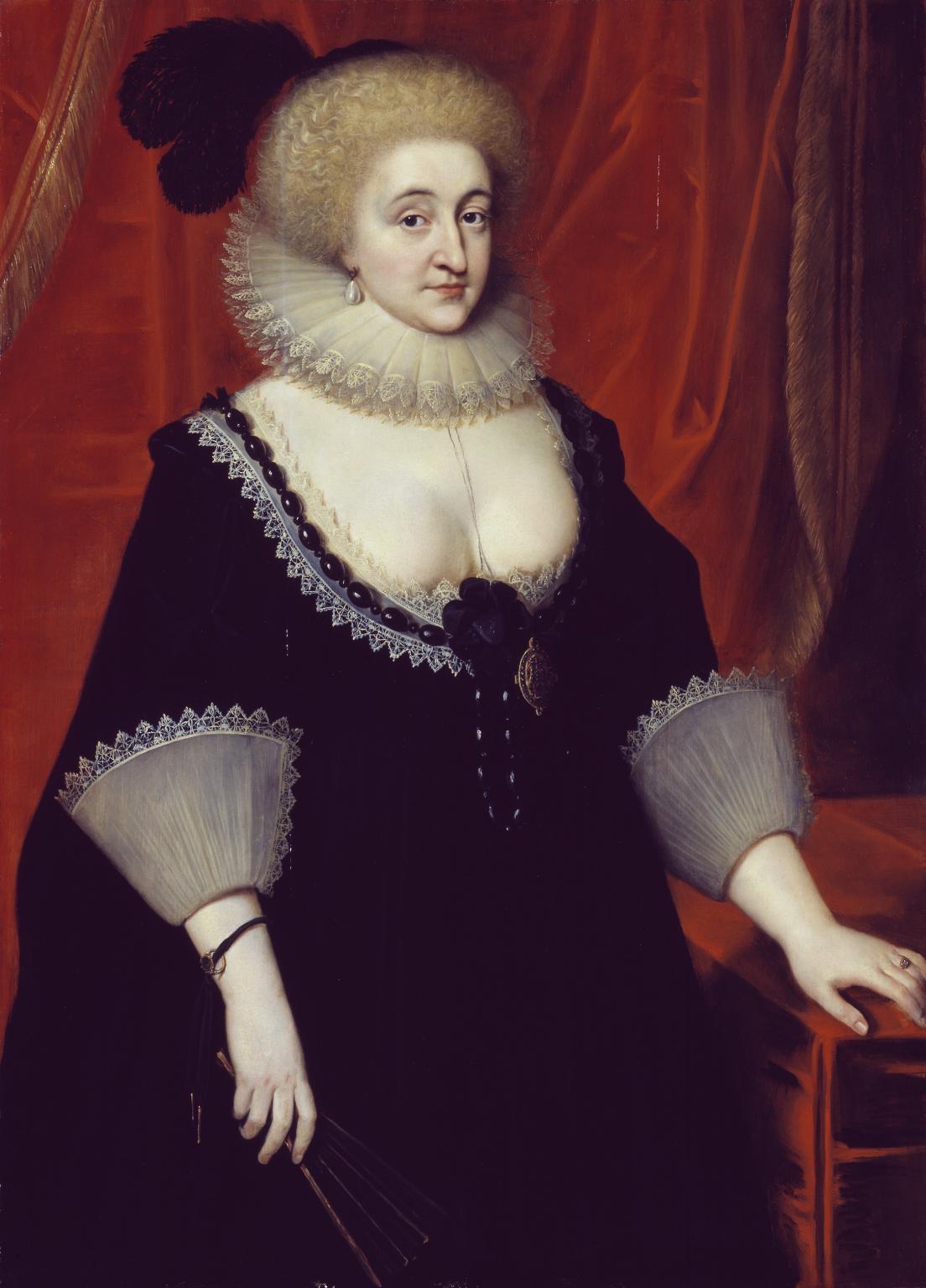
Paul Van Somer, Lady Elizabeth Grey, Countess of Kent c.1619
Paul van Somer came to Britain in 1616 and worked for Anne of Denmark, queen to King James (VI of Scotland and I of England). This portrait may relate to her death in 1619, as the sitter, who is dressed in black, was a favoured attendant of Queen Anne. Under her heart, Lady Kent wears a jewel with the crowned monogram ‘AR’, standing for the Latin Anna Regina (meaning ‘Queen Anne’). It is probably a closed miniature-case, as we know a very similar example was given by the queen to another lady-in-waiting.
Gallery label, July 2024
11/24
artworks in Exiles and Dynasties

George Gower, Lady Kytson 1573
George Gower painted these portraits of Lady Elizabeth and Sir Thomas Kytson in London in 1573. Gower, who was from a family of Yorkshire gentry, was an important portrait painter in the 1570s and 1580s. In 1581 he became Serjeant Painter to Elizabeth I, and supervised decorative painting in the royal palaces. In 1584, Gower and the miniaturist Nicholas Hilliard tried to gain a monopoly to produce Elizabeth I’s portraits. As this painting demonstrates, Gower worked in the linear, shadowless style that the Queen is known to have preferred.
Gallery label, July 2024
12/24
artworks in Exiles and Dynasties
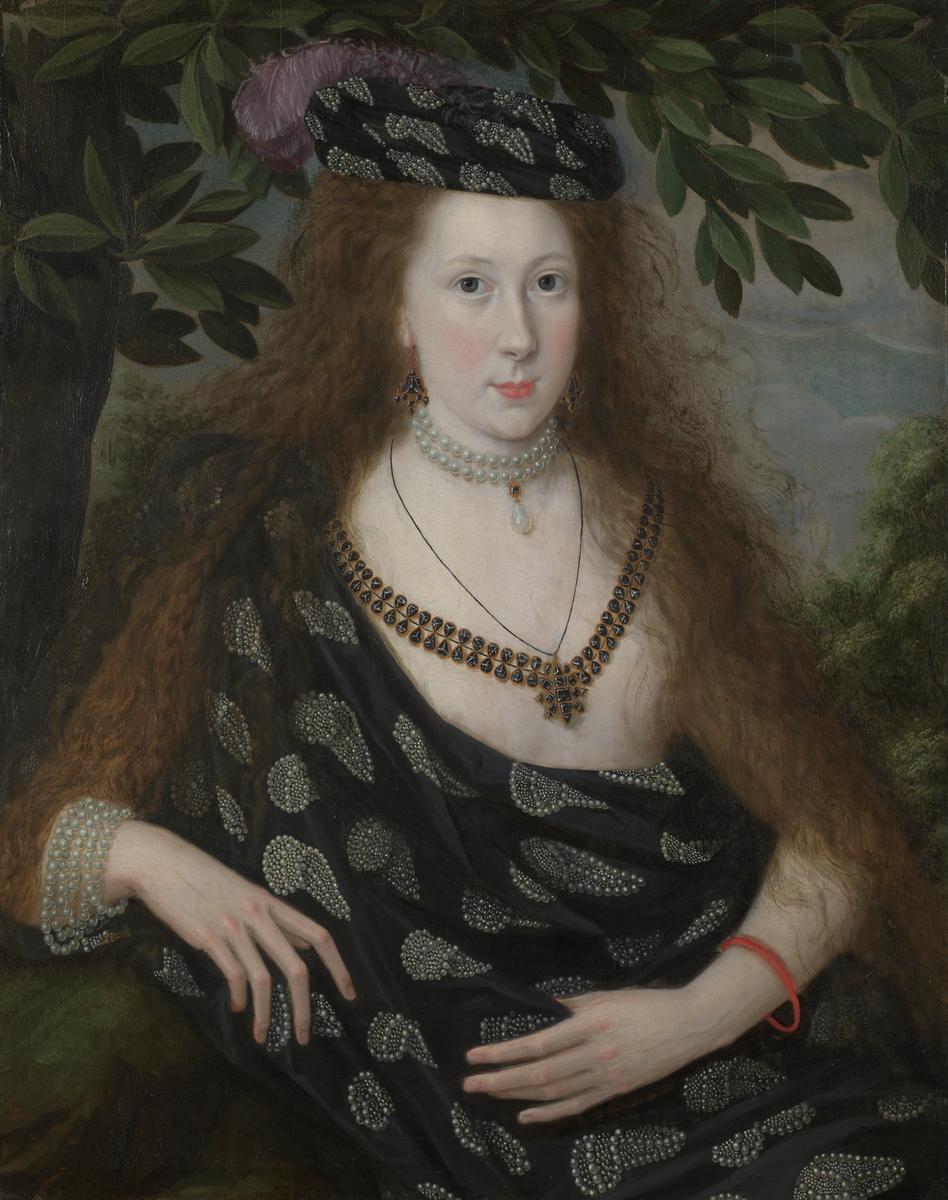
attributed to Robert Peake, Lady Elizabeth Pope c.1615
George Gower painted these portraits of Lady Elizabeth and Sir Thomas Kytson in London in 1573. Gower, who was from a family of Yorkshire gentry, was an important portrait painter in the 1570s and 1580s. In 1581 he became Serjeant Painter to Elizabeth I, and supervised decorative painting in the royal palaces. In 1584, Gower and the miniaturist Nicholas Hilliard tried to gain a monopoly to produce Elizabeth I’s portraits. As this painting demonstrates, Gower worked in the linear, shadowless style that the Queen is known to have preferred.
Gallery label, July 2024
13/24
artworks in Exiles and Dynasties

Unknown artist, Britain, A Young Lady Aged 21, Possibly Helena Snakenborg, Later Marchioness of Northampton 1569
This portrait might have been painted by the artist known as The Master of the Countess of Warwick. The sitter has traditionally been identified as Helena Snakenborg, Elizabeth I’s maid of honour who became a powerful figure at court. In 1565 she had visited England with the Swedish princess Cecilia, remaining there as the fiancée of the elderly Marquis of Northampton, whom she was to marry in 1571. The carnation behind her ear may be a symbol of her betrothal.
Gallery label, July 2024
14/24
artworks in Exiles and Dynasties
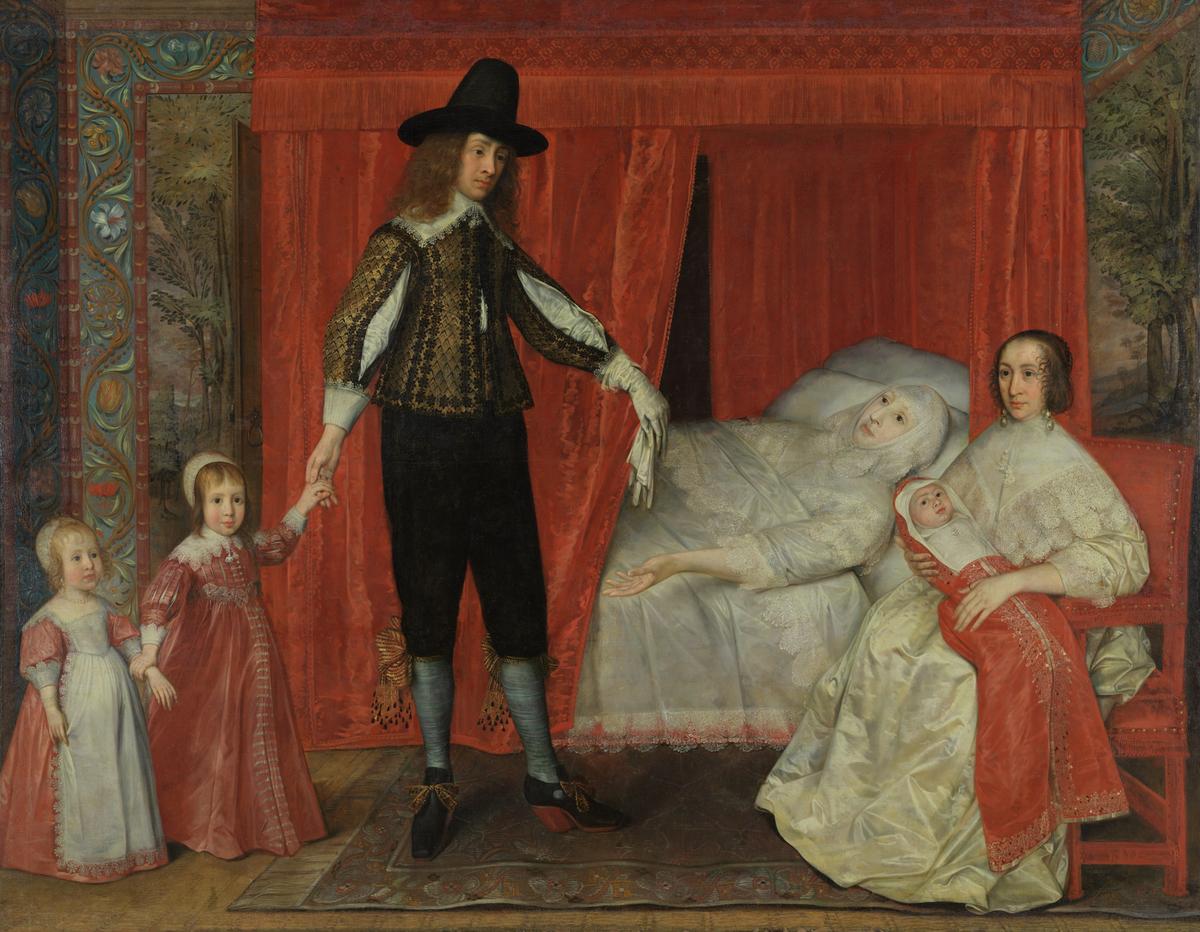
David Des Granges, The Saltonstall Family c.1636–7
This large, unusual, group portrait seems to take its inspiration from the elaborate family tombs of the time, where the living and the dead are shown together. We think it shows Sir Richard Saltonstall and his family. He draws back the red curtain round the bed that contains his deceased first wife. She gestures towards the couple’s two surviving children. Meanwhile, he gazes towards his second – living – wife, who sits holding her own Saltonstall baby. The artist, David Des Granges, mainly painted small-scale portrait miniatures.
Gallery label, July 2024
15/24
artworks in Exiles and Dynasties
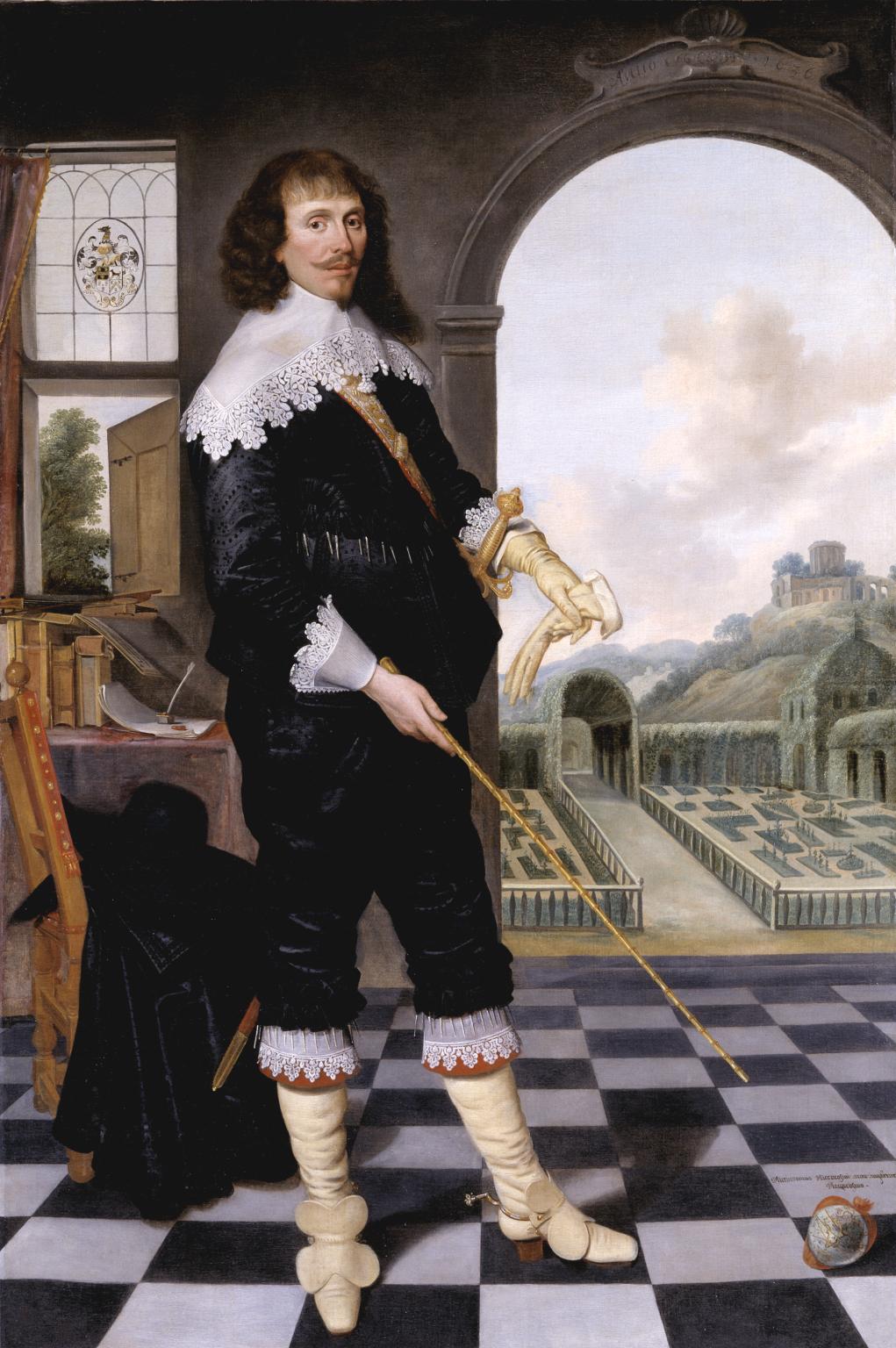
Unknown artist, Britain, Portrait of William Style of Langley 1636
William Style was a lawyer involved in the Counter-Reformation religious movement and his portrait is full of symbolic elements. The emblem on the floor and its motto proclaim that the human heart cannot be satisfied by worldly matters but burns for the spiritual life. Style rejects the trappings of his earthly life, represented by his family arms set in the window, by his books and writings and by the small violin. Instead, he moves towards the Church, symbolised by a closed garden, beyond which lies a pagan wilderness, including a classical ruin.
Gallery label, July 2024
16/24
artworks in Exiles and Dynasties
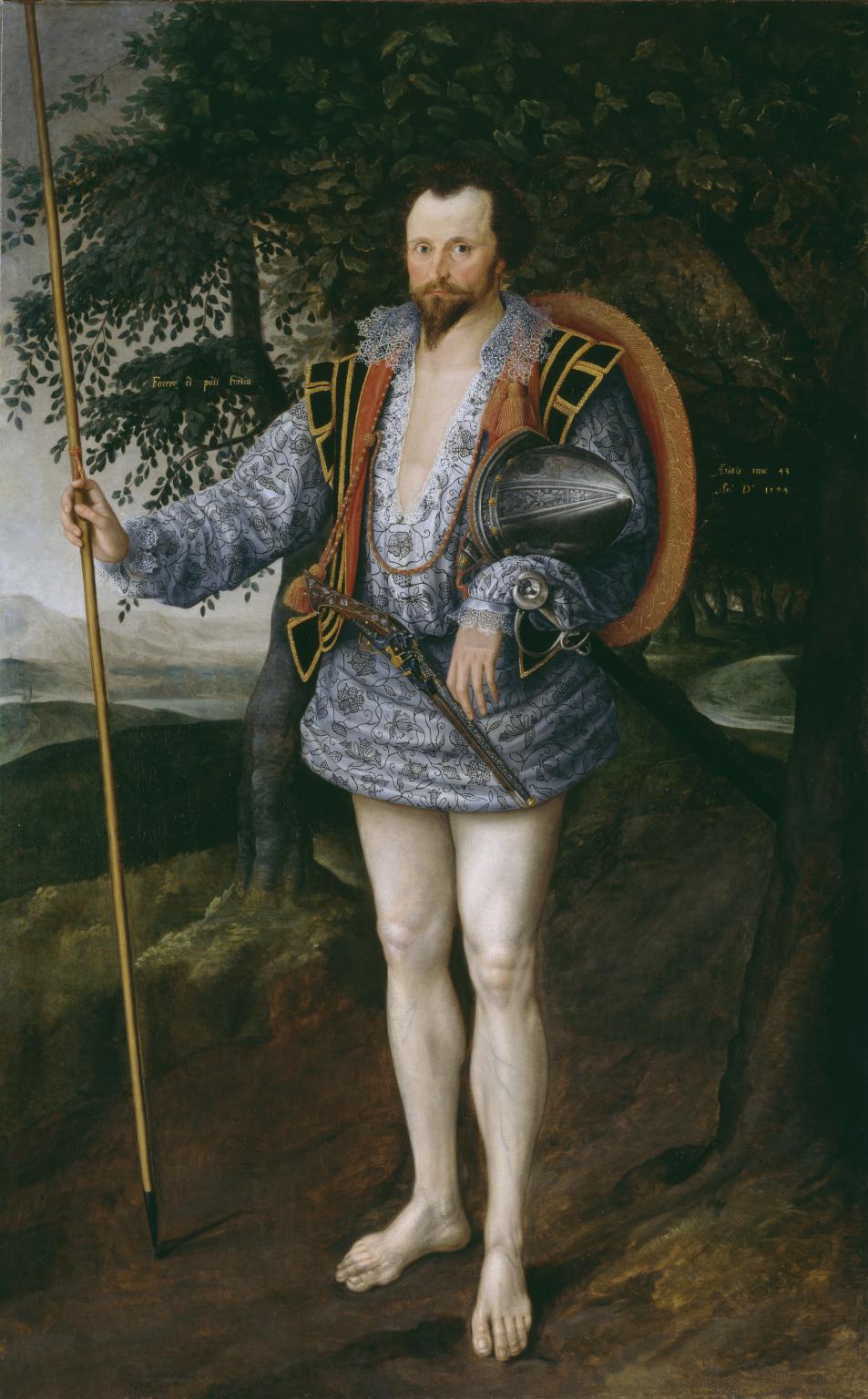
Marcus Gheeraerts II, Portrait of Captain Thomas Lee 1594
This striking portrait is highly political. Thomas Lee was an officer in Elizabeth I’s army, fighting to colonise Ireland. His expensive embroidered shirt and ornate armaments express wealth and status. Yet his bare legs refer to the uniform of Irish kerns (foot soldiers), the lowest status fighters. This may be a reference to Lee’s complaints that English officers in Ireland were poorly paid. The portrait was probably produced to show Lee’s loyalty to the Queen after he was suspected of treachery. He seems to be saying that despite appearances, he is loyal to his own side.
Gallery label, July 2024
17/24
artworks in Exiles and Dynasties
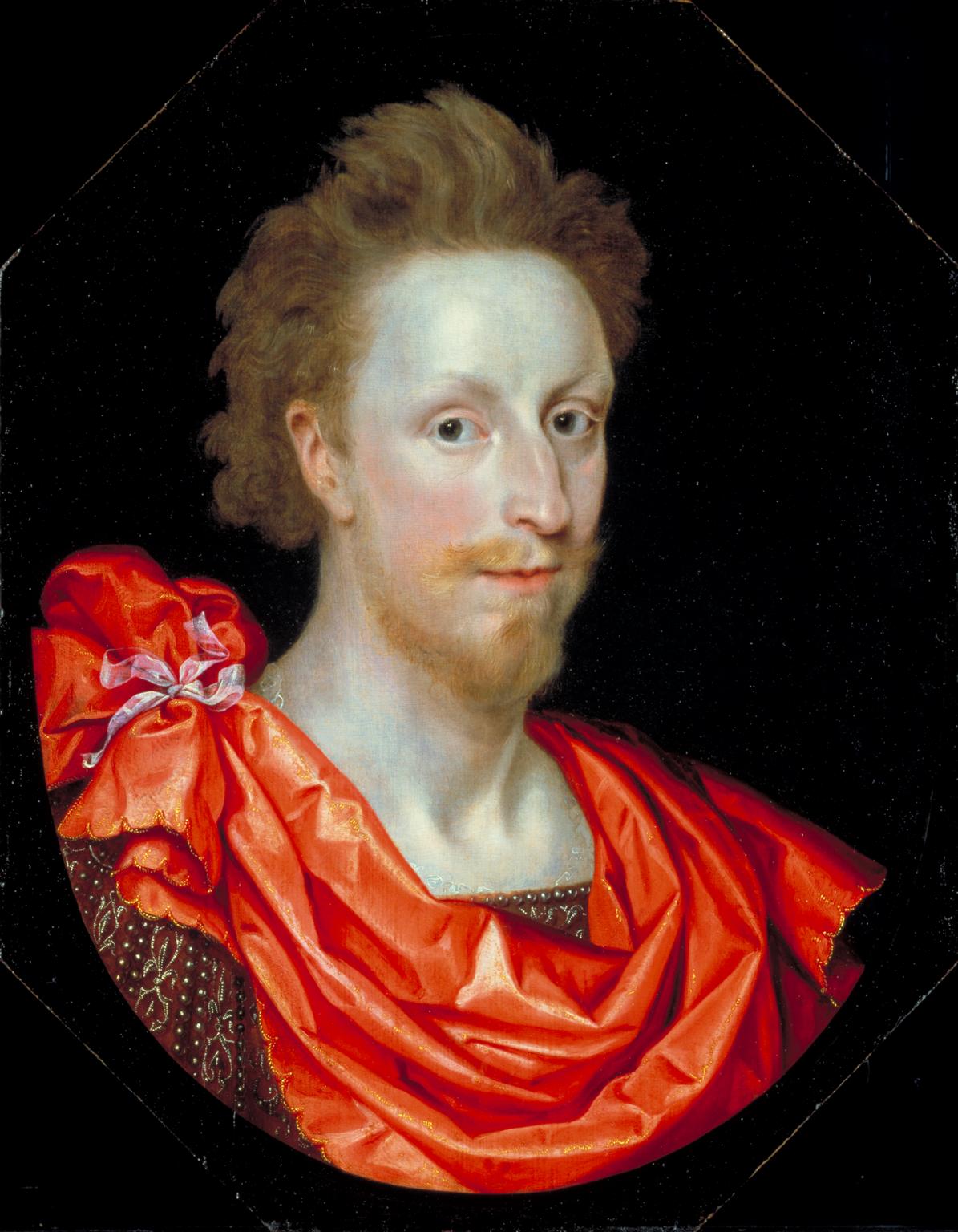
Marcus Gheeraerts II, Portrait of a Man in Classical Dress, possibly Philip Herbert, 4th Earl of Pembroke c.1610
Philip Herbert was a wealthy aristocrat who boosted his income from large land holdings in England with colonial trading interests. In 1612 he became a member of the council of the Virginia Company, which colonised the east coast of North America. He was also a founder of the Northwest Passage Company, and of the Guiana [Guyana] Company. Herbert was a member of the East India Company from 1614 and probably had commercial interests in the Caribbean.
Gallery label, July 2024
18/24
artworks in Exiles and Dynasties
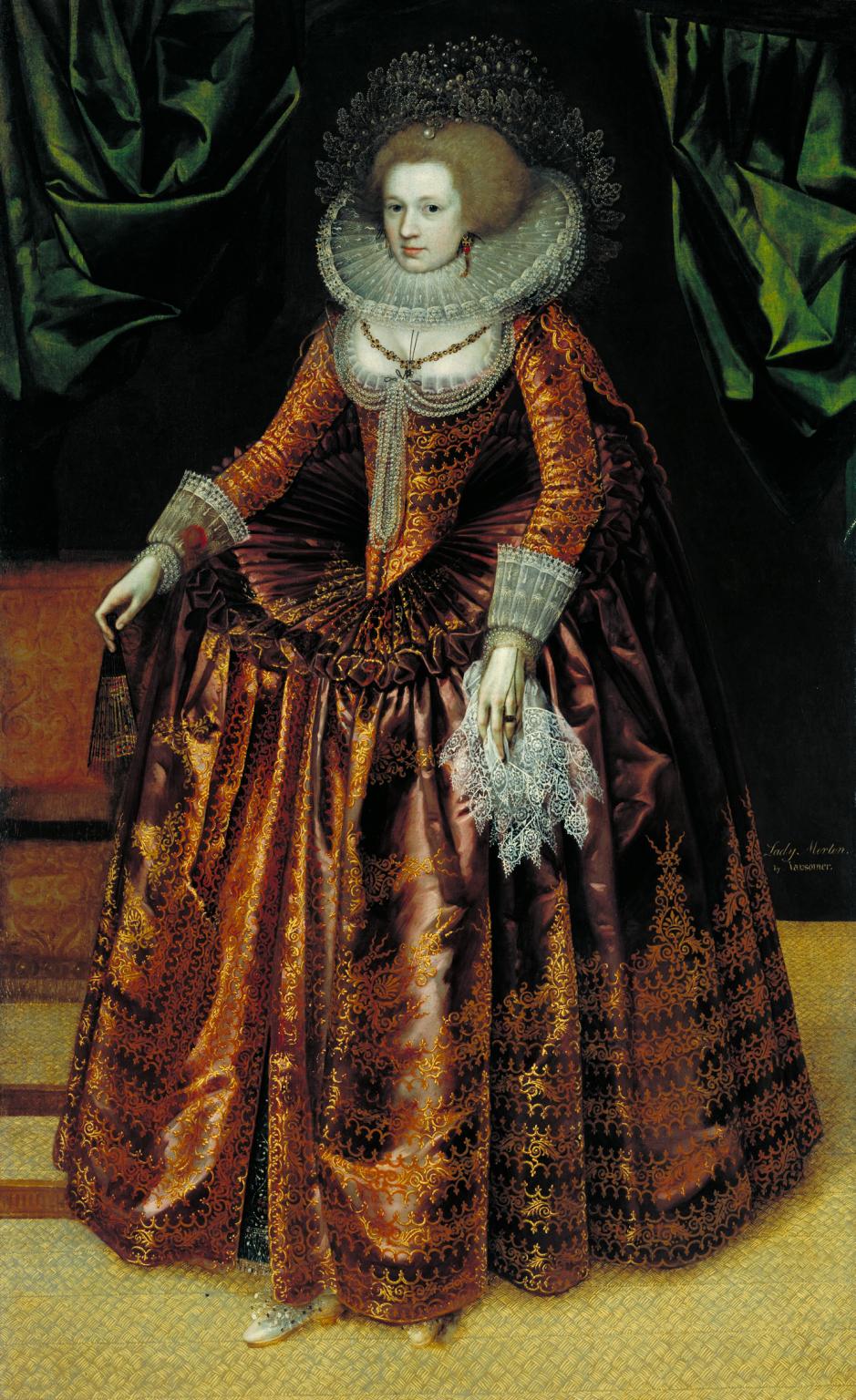
Unknown artist, Britain, Portrait of Anne Wortley, Later Lady Morton c.1620
Anne Wortley, the sitter in this portrait, was the sister-in-law of Sir Henry Lee, cousin of his namesake, the Queen’s Champion. It was displayed at the Lee family residence of Ditchley house, Oxfordshire. The composition typifies the British Jacobean ‘curtains and carpet’ portrait formula. The subject appears full length and almost facing the viewer, flanked by lustrously painted curtains, though here standing on rush matting rather than an on a rich carpet. The artist is unknown, but it may have been produced by painters collaborating in a workshop.
Gallery label, July 2024
19/24
artworks in Exiles and Dynasties

George Gower, Sir Thomas Kytson 1573
Sir Thomas (1540–1603) and Lady Elizabeth Kytson (1546/7–1628) of Hengrave, Suffolk, married in 1560. Sir Thomas was the son of a rich cloth trader, who amassed a fortune trading in the Low Countries (now the Netherlands, Belgium and Luxembourg). This meant Thomas could live in considerable style. The Kytsons remained Roman Catholics throughout the Protestant reign of Elizabeth I. Elizabeth Kytson was even briefly imprisoned for her faith. Nonetheless, the Queen honoured Thomas by visiting Hengrave in 1578, where she knighted him.
Gallery label, July 2024
20/24
artworks in Exiles and Dynasties
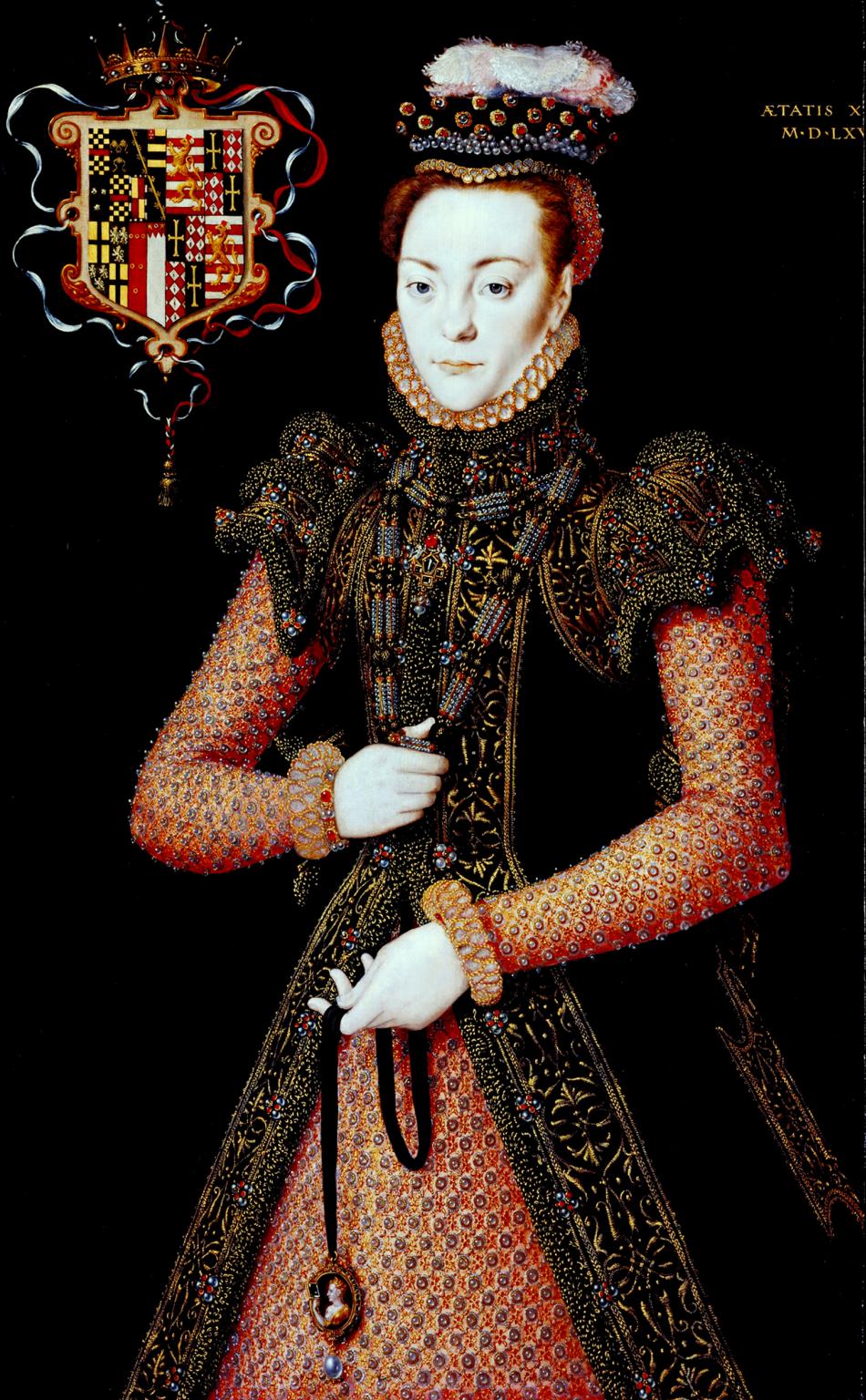
Hans Eworth, Portrait of an Unknown Lady c.1565–8
The rich dress and jewels show that this woman was of high rank, although her identity is unclear. She wears a cameo, suspended on a black ribbon. It shows the figure of Prudence, one of the cardinal virtues. The remains of an inscription, upper right, date the picture to between 1565 and 1568. The large heraldic arms were added later. They belonged to Lady Eleanor Brandon, but she cannot be the woman depicted because she had died in 1547, around 20 years before this was painted.
Gallery label, July 2024
21/24
artworks in Exiles and Dynasties
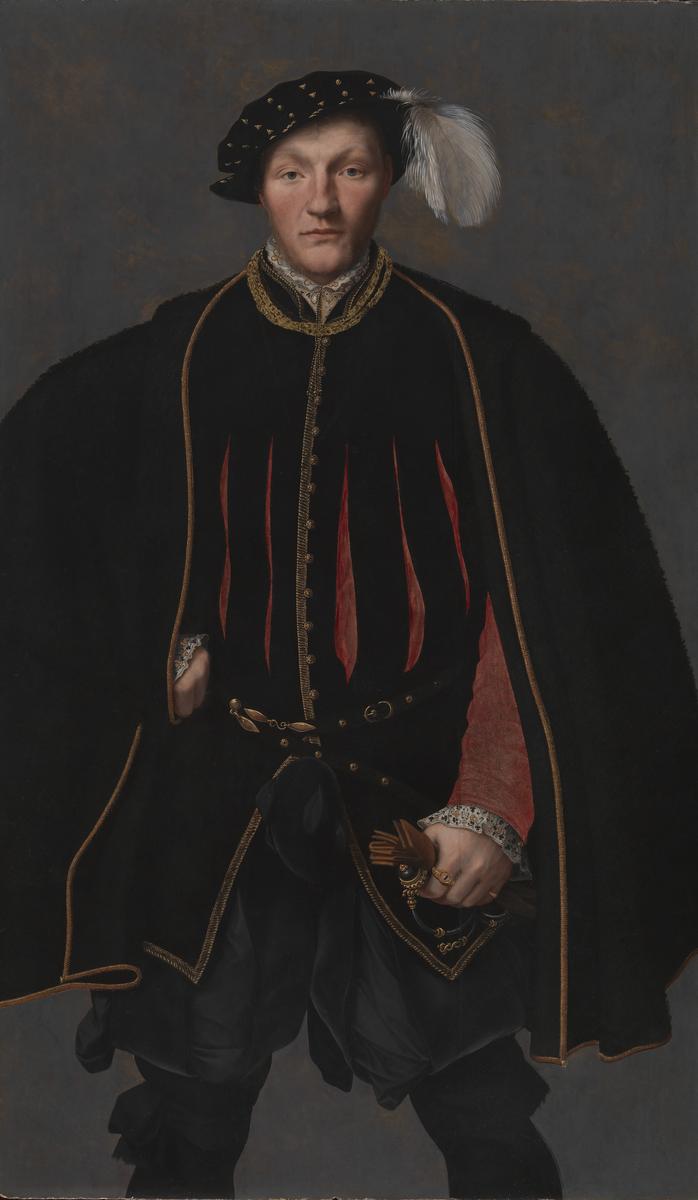
Unknown artist, Britain, formerly attributed to ?British School, ?16th Century, formerly attributed to Hans Holbein the Younger, Portrait of a Gentleman, probably of the West Family 1545–60
We think this sitter is William West (born 1519), later Baron De La Warr and nephew of the 9th Lord De La Warre, whom he tried to poison to gain the family estates. The ring he wears bears a heraldic motif associated with the West family. Analysis of the oak panel and the pigments used, along with the style of clothes and design of the sword hilt, dates the work to around 1550. The full-frontal pose shows the influence of the iconic portrait of Henry VIII by Hans Holbein, painted in the 1530s.
Gallery label, July 2024
22/24
artworks in Exiles and Dynasties

Sir Anthony Van Dyck, A Lady of the Spencer Family c.1633–8
Anthony van Dyck gave his royal and aristocratic sitters an unprecedented glamour and elegance and had a profound influence on the course of British portraiture. The identity of this woman is uncertain. The dog, and the lizard it is chasing, are symbols of fidelity, which suggest she may have been engaged or newly married. Van Dyck was born and trained in Antwerp. He worked in Rubens’ studio and then travelled in Italy, studying the work of Titian. He moved to London in 1632 when he was knighted and appointed Charles I’s Principal Painter.
Gallery label, July 2024
23/24
artworks in Exiles and Dynasties
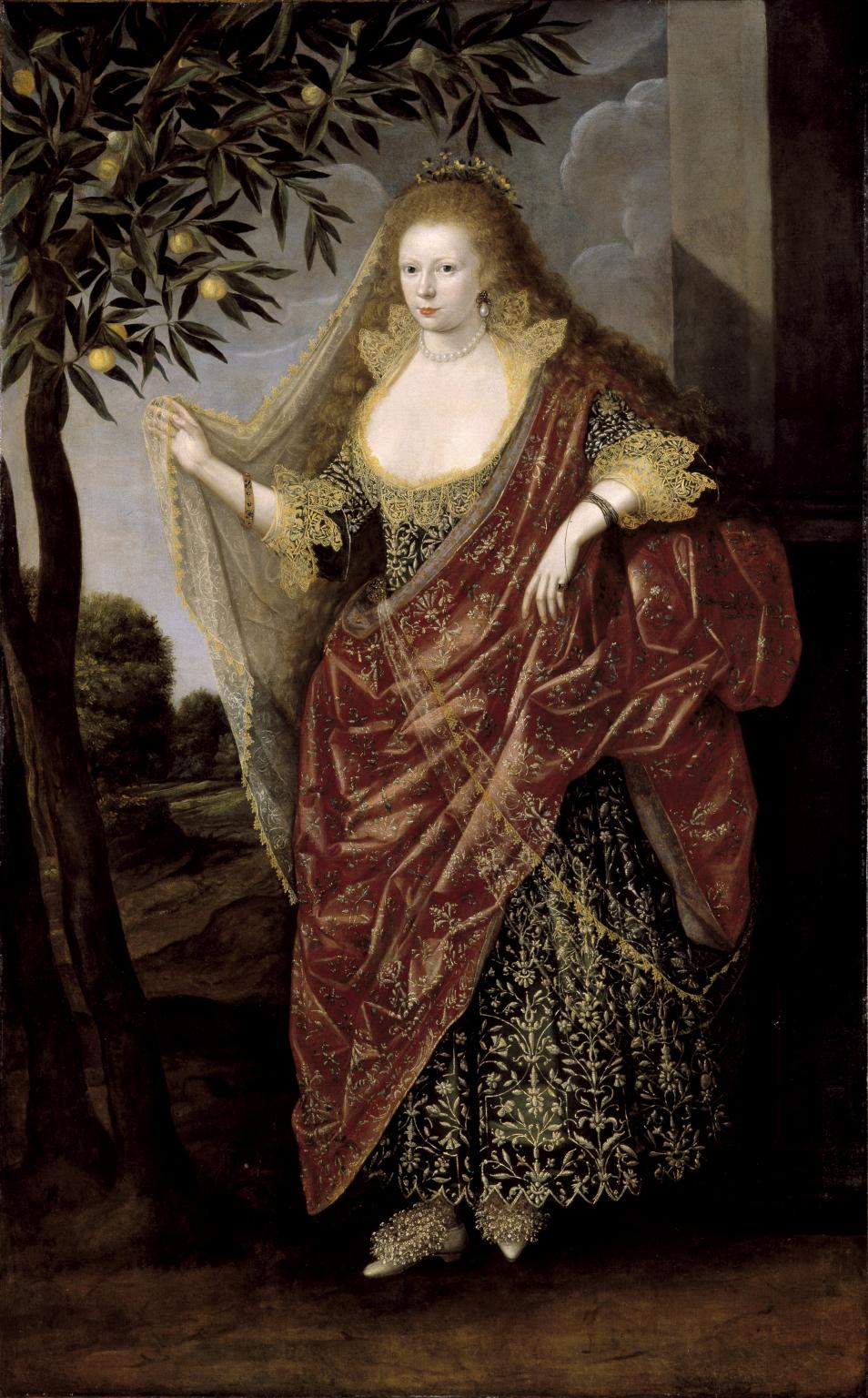
Unknown artist, Britain, Portrait of a Lady, Called Elizabeth, Lady Tanfield 1615
This portrait is thought to depict Elizabeth Tanfield (1585/6–1639). She was an extraordinary woman for her time: a poet, playwright, translator, and historian. Tanfield is the first woman known to have written and published an original play in English. From an early age she was recognised as an accomplished scholar. The painting includes several unusual features, including the flowers in her hair, the peach tree, and the lifting of her shawl as if to shield the sun. This suggests that the portrait had a symbolism and personal meaning that is now lost.
Gallery label, July 2024
24/24
artworks in Exiles and Dynasties
Art in this room


Sorry, no image available





















You've viewed 6/24 artworks
You've viewed 24/24 artworks
Responses
-
On display at Tate Britain part of Historic and Modern British Art
